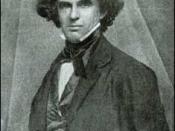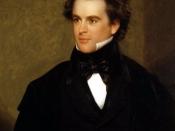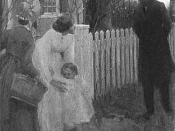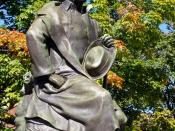The definition of a parable presents itself as a story illustrating a moral or religious lesson. As the title of Hawthorne's story suggests, "The Minister's Black Veil: A Parable,"� should consist of messages and themes that convey a righteous and moral lesson. A moral lesson concerning sins concealed by every man and woman obviously presents itself within the story. However, parts of the story also indicate a deeper and darker theme that avoids the common traveled road of morality. In "The Minister's Black Veil,"� Hawthorne seems to suggest everyone must atone for his or her secret sins, but such an obvious theme is open to further analysis and inspection.
The black veil Hooper dons symbolizes some unspeakable sin committed by the reverend. This simple piece of crepe affects the townspeople profoundly. Rumors fly about, eyes are glued upon the minister, people dread the approach of Hooper, and so on.
The townspeople, his parishioners, even his own wife rejects the new Hooper. The most common theme associated with the story is that those who reveal their sins will be ostracized from a society of people who choose to conceal their sins (Reed 1502-1503). Hawthorne keeps Hooper's sin concealed throughout the story, but some critics concur "Hooper's veil is somehow related to the girl whose funeral takes place on the Sunday he first wears it"� (Newman 204). Consequently, many laud Hooper's attempt to atone for his sin by committing a deep, symbolic act to reach other sinners who still shy away from the darker side of his or her life. Hooper's actions may be seen as a valiant quest to serve the truth. He does not fear sin, sin fears Hooper as he confronts the sins of his flock (204-206).
In contrast, Hawthorne also uses irony to criticize Hooper's excessive, religious ego when trying to exploit the sins of others (Newman 205). Supposedly, ministers serve god and employ love and understanding to help people. Instead, Hooper becomes a more efficient clergyman by using the evil and darkness represented by the veil. Fogle states within his book that his "converts regard the minister with dread, not with love or joy, even though they owe their redemption to him"� (38). In this case, Hooper already damns himself and endangers all those he converts. A critic by the name of Stein, views Hooper as an Antichrist because he "so terrifies his followers with an all-encompassing, dark vision of evil that he denies the light of Christian redemptive love"� (Newman 205). Hooper takes advantage of his position so as to force even the most innocent of people to dread themselves and their sins. One event from the story conveys the darker side of Hooper's actions. When Hooper spills wine at a wedding, this symbolizes blasphemy and sacrilege on his part (205). So now, Hooper's credibility as a minister becomes muddled and must be questioned due to this ironic twist. Given the circumstances, one cannot hope to conclude on Hooper simply being a man on a noble quest. This one question seems to convey this concern perfectly: "Is it advantageous to be ministered to by a "ÃÂmind diseased?'"� (3: 1147).
By adding the subtitle stating the story as a parable, Hawthorne opens up the story to biblical allusions. The Bible may better explain Hooper's actions than the factual footnote concerning Mr. Moody; the factual reverend Hooper was to be based upon. Moses acts as a good example: When Moses returns to the children of Israel after spending forty days and forty nights in the presence of God "ÃÂthe skin of his face shone; and they were afraid to come nigh him' (Exodus 34:30) until Moses "ÃÂput a vail on his face' (Exodus 34:33), a "ÃÂvail' that he removes when he enters the tabernacle to speak with the Lord. (Dryden 135) The act of veiling by Hooper indicates that mankind is not ready to face the God yet. Therefore, they shall remain spiritually blind and veiled against the truth until they are ready to remove the veil. This may indicate that Hooper feels as if his followers may not be spiritually knowledgeable to receive whatever truth is being hidden. However, the Bible also suggests this: "Nevertheless when it shall turn to the Lord, the vail shall be taken away"� (135). Hooper refuses to remove his vail upon his deathbed, meaning that maybe he too is also spiritually unfit. As the title suggests, maybe Hawthorne intended his story to be like a parable. Christ decides to adopt a parabolic mode of teaching that both revealed and concealed at the same time. Though one may think he or she knows the meaning of a parable, the true meaning only becomes apparent to the inner circle of those who are truly attuned to God (137-138). Considering this, maybe Hawthorne wrote this story to appease the common man, but at the same time kept hidden the true meaning of the story to the common, spiritually blind man.
In addition, Hawthorne also uses a mysterious tone to emphasize the parabolic nature of the story. The veil may suggest a horrible crime and Hawthorne does not provide any evidence in the story to suggest one was committed. The veil may very well represent a horrible crime, or it could just symbolize a veil upon his understanding so as to darken all that is seen. He presents the reader with actions but no explanations. Multiple interpretations may be derived but none truly correct. Such an ambiguous tone may very well lead individuals to various conclusions about the story based on their personal feelings (Fogle 38-40).
Due to the nature of the story, multiple interpretations of the theme may be derived other than the one of people acknowledging their secret sins. Though initially the story may seem to be about a noble man on a quest to make people aware of their sins, there are also signs of a sin-crazed priest who takes advantage of his power with the black veil. A story that may seem so obvious at first becomes even more complex after multiple readings. More questions come up than answers as the story is read more and more. Maybe Hawthorne never intended for people to truly understand his story. If this is so, then he has certainly done a good job, for man may never know why Hooper decided to don the black veil.
Works cited Dryden, Edgar A. "Through a Glass Darkly: "ÃÂThe Minister's Black Veil' as Parable."� New Essays On Hawthorne's Major Tales. Ed. Millicent Bell. New York: Cambridge University Press, 1993. 133-149.
Fogle, Richard Harter. Hawthorne's Fiction: The Light & the Dark. Norman: University of Oklahoma Press, 1952.
"Nathaniel Hawthorne."� Critical Survey of Short Fiction. Ed. Frank Magill. Vol. 3. Englewood Cliffs: Salem Press, 1993. 1142-1150.
Newman, Lea Bertani Vozar. A Reader's guide to the Short Stories of Nathaniel Hawthorne. Boston: G.K. Hall & Co., 1979.
Reed, Micheal D. "The Minister's Black Veil."� Masterplots II: Short Story Series. Ed. Frank Magill. Englewood Cliffs: Salem Press, 1986. 1501-1504.





